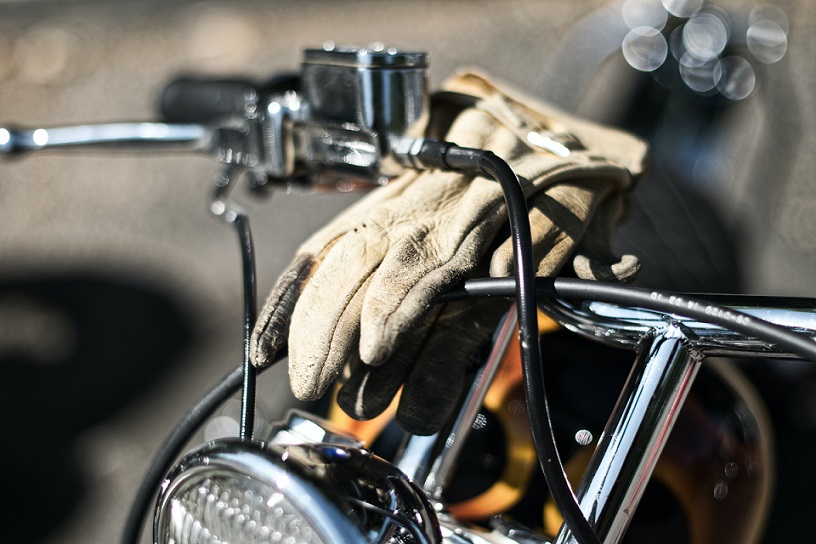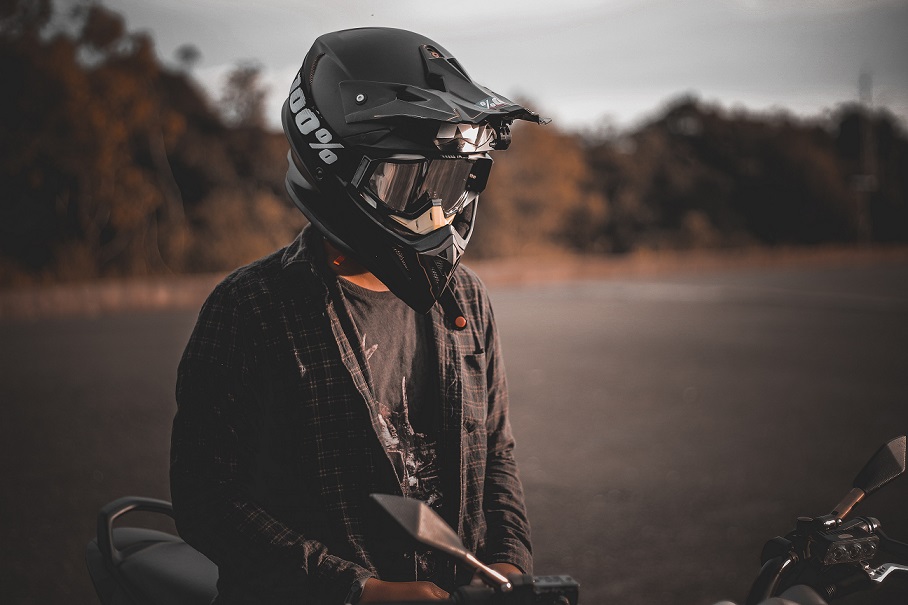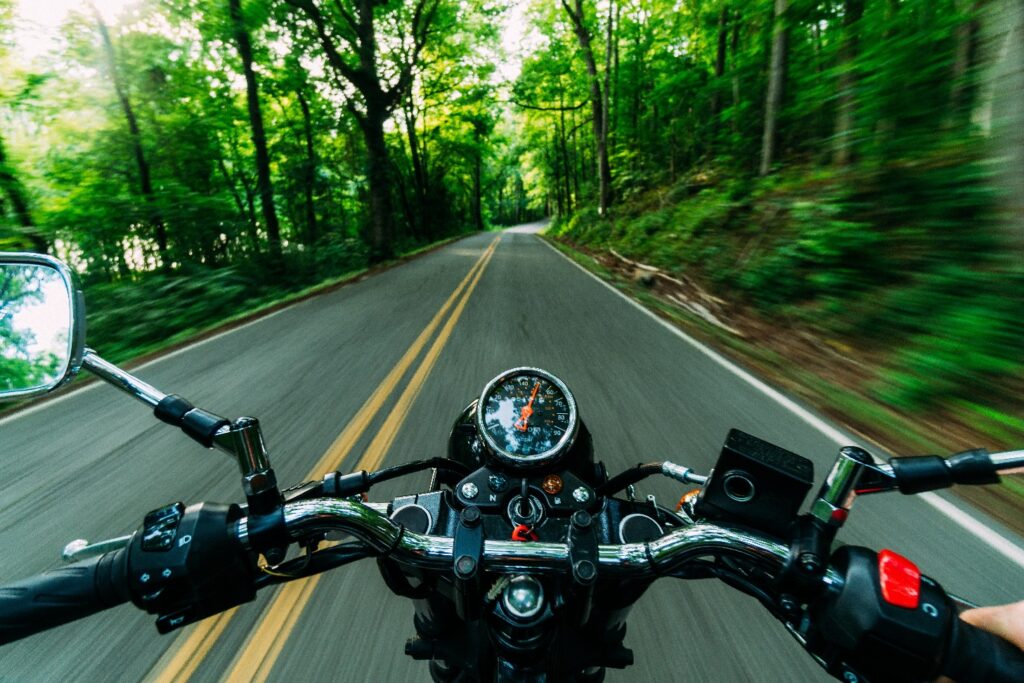Riding motorcycle in cold weather is a completely different experience when compared to riding in summers. The chilly atmosphere, harsh winds, and the foggy roads make it difficult for the motorcycle rider to navigate easily.
While adhering to common safety standards are required, there are a few more additional things that a motorcycle rider needs to look into for a safe cold weather riding.
Here are 11 motorcycle riding tips to follow while traveling in a cold weather or during winter season.
#1 Use Brake Lights To Make Your Presence Known
During winters, the road you are taking might be filled with snow, fog and/or mist.
Specially in the highways where the vehicles travel at higher speeds, the going gets tough if the rider is not able to see far ahead of the road clearly. The foggy weather makes it really difficult for the eyes to make out other vehicles even right in front of you.
To avoid the risk of a vehicle hitting you from behind because the rider couldn’t see you and your motorcycle not until the last moment, you should use the brake lights. Brake lights help in making your presence known.
The red light at the rear end of your motorcycle gives a clear indication of your presence to the vehicle behind you. The red light is far more visible than the motorcycle and your colors.

So, use the brake lights to your advantage and make your presence known to the vehicles riding behind you.
For this utility, make sure your brake lights are in proper working condition first. Broken light or flickering light won’t do any good. Repair them if they are not at their best working condition.
Brake lights are far more important than we give them credit for, especially in winters.
#2 Apply Brakes Every 5 Minutes On Foggy Roads
This is an extension of the above point where we mentioned to use brake lights to make your presence known.
If the path you are riding your motorcycle on is too foggy, then you need to make your presence very clear to the vehicle riding right behind you.
As mentioned earlier, you can use brake lights here. But brake lights wont light up until and unless you apply brakes.
That’s why you need to constantly use the brakes to switch the rear end brake lights. This will signal your presence to the vehicles behind you. And not just that, it will also make those vehicles to slow down their speed.
Now, applying the brake once is not sufficient. You need to constantly remind the people behind you of your presence. Apply the brakes at regular intervals. A 5-minute interval should be an ideal frequency to go for it.
By applying brakes, you are also maintaining a consistently lower speed than you would have teed off in summers. Maintaining a lower speed is vital while driving in winters since the cold makes it tough for you to focus.
#3 Maintain A Safe Following Distance of 2 Seconds
The 2 second rule is simple. The distance between you and the vehicle in front of you should be the distance you can travel in 2 seconds at your current speed.
For example, if you are travelling 36 kmph, your speed per minute translates to 0.6 kilometres per minute. This in turn is 10 meters per second. You can travel 20 meters in 2 seconds.
So, the safe following distance here is 20 meters.
Similarly, if you are travelling fast at a speed of 72 kmph, you need to maintain a distance of 40 meters from the vehicle in front of you.

While this is something you must follow all time. The significance increases multi fold during rainy and winter seasons.
The possibility of road hazards increases during these seasons and hence the safety protocols become much more important.
That’s why you have to maintain a healthy safe following distance between you and the vehicle traveling in front of you.
#4 Brake Fluid, Brake Pad, Disc And Drum Brake Should Be Healthy
Okay. This is important.
Your motorcycle should be in a very good condition whenever you go for a ride.
And during winters, the health condition of your bike becomes more pronounced. Especially the braking system.
At any point, while you are riding on a road in winter, you want to halt the motorcycle easily. The foggy roads and cold weather make the riding tough and lowers your mental concentration.
If while riding, you come uncomfortably close to another vehicle, you would want to slow down or even halt. And you need your motorcycle braking system to be in absolutely good condition for that.
So, check the brake pads, disc brake, drum brake, callipers, and the braking fluid. All these components should be in good condition. If not, visit your mechanic or the service shop for maintenance and repair.
#5 Use Riding Gloves
Motorcycle riding gloves are a must whenever you are going out for a ride in winters.
Consider the case where you are riding without the gloves in winter. The cold weather will start affecting your hands. Slowly but surely your hands will start feeling numb and the grip on the handlebar will start to loosen up.
The intensity of numbness on your hands will if anything increases drastically as you ride more.

In order to protect your hands from the weather and prevent from numbing, you need to wear the riding gloves.
Even normal gloves won’t be a perfect fit since they won’t provide the same comfort and grip on the handlebar as much as the riding gloves.
In addition, the motorcycle gloves will also help in preventing calluses, protecting from weather conditions, fatigue and numbness along with increasing the grip and comfort. Not to mention, riding gloves look cool as well.
#6 Clean Your Helmet Visors/Face Shield
Riding in cold weather is not at all easy. The harsh weather makes it difficult for the motorcycle rider.
Add to it, foggy roads which makes it impossible to see beyond five meters.
Due to the cold weather, you would want to pull down the helmet visor. The visor will protect you from the harsh cold winds passing against your face.
However, this creates a small problem. Pulling the visor or the face shield down will make the vision blur if the visor is not clean enough. Add to it the accumulating fog on the shield.

For this reason, you must clean the visor properly before going out for a ride in cold weather.
An unclean visor will hinder your vision or worse, you will be forced to drive without the visor pulled down. Your face will be continuously hit with harsh cold winds.
#7 Wear At Least 3 Layers Of Clothing
This is an obvious tip. Yet that needs a separate mention since I have seen my fellow riders completely disregarding this simple thing.
When you are riding in cold weather dress like you are riding in cold weather. Period.
In other words, wear as much clothing as possible to keep you more than warm enough.
There is a difference in the cold that you feel by just standing out there and with the cold that you feel while riding.
The speed with which you are traveling in your motorcycle increases the intensity of cold that you will experience while riding.
If the clothes you have worn is just warm enough while standing in the weather, then it is not at all sufficient.

Wear at least three layers of clothing which must include your motorcycle riding gear and jacket. The intensity of cold will be much higher while you are riding since winds hit you with more force. Higher the peed larger will be the impact of wind.
Make sure you are dressed more than sufficient to withstand the cold you will be facing in a wintery motorcycle road.
#8 Install Hazard Light or Fog Light
Hazard lights or fog lights are super helpful if your location has foggy weather throughout the winter season.
Few modern motorcycle models have fog lights attached them from the manufacturer’s end. However, this is not an universal feature available in all motorcycle models.
In case your motorcycle does not have hazard lights or fog lights attached at the front end, consider installing them. This is specifically vital for riders living in places that have foggy weather most of the winter.
Fog lights are specifically designed to provide extra beam to the motorcycle rider. However, if you are installing fog lights, you need to check the legalities of installing auxiliary lights in your area.
Depending on the area you live in, there might be regulations specifying the maximum distance the light can shine, the maximum height from the floor wherein the lights can be installed etc.
Also, you need to look into the power requirements of the fog lights before installing. If the fog lights drain too much power than your motorcycle can handle, then it would be a mismatched installation.
Make sure to keep in mind these requirements before you go for installing auxiliary fog lights in your motorcycle.
#9 Maintenance And Repair
This tip is something so basic yet motorcycle riders invariably ignore it.
If any component of your motorcycle is not functioning at its maximum capacity, you need to address that.
Maintaining your bike at its healthiest condition is an important aspect not just during winter but for all seasons.
The better condition the motorcycle is in, longer will be its life expectancy.
Furthermore, preventive maintenance is far more economical and less headache than repairing and reactive maintenance.
Now, when it comes to winter season, the bike components need to be in good condition mainly because of the cold weather.
Engines are tough to start in winters. Motorcycle engine oil wont function well if it is not of excellent quality under cold conditions. You will have a difficult time to start your motorcycle.
All these challenges are common during cold weather. And if your motorcycle is not in good health, these issues will amplify. Trust me on this. You don’t want that headache.
So, keep the motorcycle in a healthy condition before the winter starts in your locality. A better approach is to service your motorcycle right before the onset of winter season.
#10 Take Extra Precaution while Overtaking
Overtaking another vehicle becomes a bit more complicated in winter when compared to summers.
You need to account for the vehicles behind you, the vehicles coming from the opposite direction, and of course the vehicle you are overtaking – all combines in a cold foggy weather where you can’t see beyond five metres clearly.
Not to mention, roads can be slippery as well.
A much better option is to lay low and continue with the slow speed without overtaking.
But, I understand, it becomes annoying when the vehicle in front of you is going too slow for your taste.
Still, exercise caution. If you have decided to overtake, look out for all the vehicles in your vicinity. In some geographies, horns are a common thing while overtaking. So, use that if necessary.
And most of all, don’t speed up too much in the zeal to overtake. If you have to speed up too much from your current speed reading to overtake, then there is no need for overtaking at all.
#11 Concentrating becomes Tough – Don’t Speed over 50 mph
Riding in winter season drains your energy.
The incessant cold, chilly wind, foggy roads will take a toll on your metal focus and concentration.
The reduced focus and the toll on concentration brings us to our next tip. Don’t speed up too much. Over 50 mph in a highway feels too much speed for a cold weather ride.

Riding at high speed requires high alert and keen concentration from the motorcycle rider. You might not realise it. But it is something that subconsciously runs on your mind to focus more while driving at high-speed levels.
And that’s the reason you need to curb that speed to lower levels.
Due to the continuous exposure to chilly weather, you are fatigued. The toll on you might not be clearly visible while you are riding. But halt down for sometime and you will instantly realize that you are tired of riding in this weather.
So, slow down your motorcycle speed and do not cross 50 mph while travelling on a highway road. And much lower speed on other roads.
These are our tips for motorcycle riding in winter. Which one did you like the most? And which major thing did we miss?
